An audience of any visual medium engages with what they see first—their first interpretation of a character, their first feeling about a place, their first opinion of a culture stems from the design. Costuming plays a multitude of roles as it can dictate, along with the set, exactly how the audience thinks and feels. One primary purpose of costuming, especially for female characters, is to make the character alluring and attractive to the audience. Most of the time, the goal is to look “good”, whatever that may mean for a particular character.
Certainly the strife of a fictional person to “look good” is a reflection of real society. Modern Western humans put great emphasis on physical appearance, so it’s no surprise our media reflects these deep desires and values. Whether those values are worthwhile is a separate issue, but I do believe costuming for major media productions absolutely can critique the overwhelming importance of beauty. And it is a fruitful exercise to engage with modern costuming with this tendency to trend towards what “looks good” in mind.
Obsession with beauty marks human history. Obsession with feminine female beauty, in particular, appears throughout multiple cultures around the world. Consequently, when considering now what is beautiful, or what makes a female character on a TV show “look good”, we must view the question through multiple lenses. The two distinct areas to begin with are the in-verse (Watsonian) lens and the real life (Doylist) lens.
In-verse, Watsonian Focus
A Watsonian focus on costuming considers how the costume functions within the universe. For example, a Watsonian explanation of show!Dany always wearing blue on Game of Thrones (GoTs) is that blue is a special Dothraki color, so she wears it to honor the Dothraki. This explanation falls entirely within the show’s universe, using only players and facts available in the universe to explain a character’s actions. It’s important to consider the Watsonian first when analyzing a costume because, if the explanation doesn’t make sense in-verse, then it may have a more sinister origin (hint: sexism, racism, homophobia, whorephobia, etc.).
Real Life, Doylist Focus
A Doylist focus on costuming asks why real-life designers made specific decisions, and allows us to engage with an artist’s explanation. For instance, a Doylist explanation of why show!Dany wears so much blue is that it just looked good on Emilia Clarke, so the costume department rolled with it. Nothing about this explanation requires meddling with characterization. It is a very pragmatic approach, simply trying to parse out why real people acted the way they did. The Doylist lens should be considered second, since this is where any issues, like sexism or racism, can appear.
In addition, we should consider whether a costume works! We must ask whether the costume hits its mark and does what it needs to do. Personally, if I like a costume, I’m willing to let a lot of the Watsonian critique slide. My favorite costume of the entire show is a season 4 Dany dress that I swear is laser-cut pleather. That knife-pleated white under skirt is also probably synthetic, since it’s an absolute bitch to knife-pleat silk.
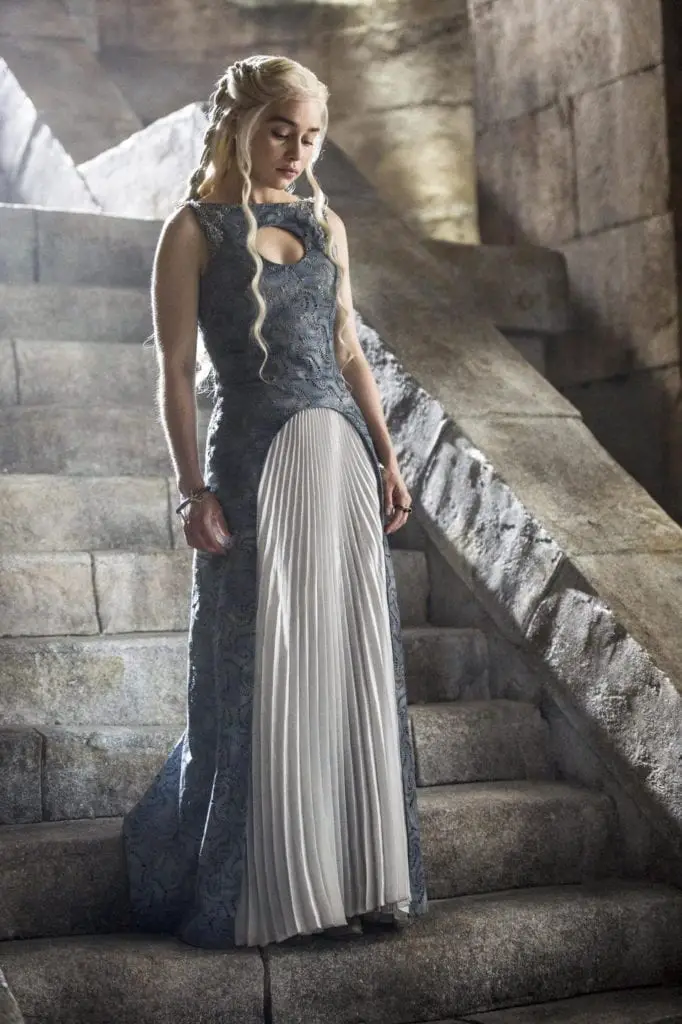
The costume fulfilling its purpose is paramount. A good costume strikes the right balance between in-verse believability and real life expectations (and restrictions!) while also functioning in its role.
Some of the best examples of both successes and failures appear in the designs for Lady Margaery Tyrell and Lady Sansa Stark. Here, we consider first show!Margaery (“Marg”) and her wildly varying levels of win and fail throughout the seasons. This analysis will be split into two pieces, with part 1 focusing on Marg’s season 2 and 3 costumes. Marg’s wedding dress and her season 6 cult dresses are the topic of Part 2.
So get out those salt thrones and some ever-so-mildly salted popcorn, and sit back for what I now fondly call A Song of Pins and Needles.
The “Funnel” Dress: A Lesson in Complete Failure
Luckily, the first costume on our list is easily Marg’s worst outfit in the series, coming out ahead of her cult costume addressed in Part 2 (coming soon!). It is a great example of utter failure on all points of design…in-verse reality, real-life motivation, and the balance of beauty.
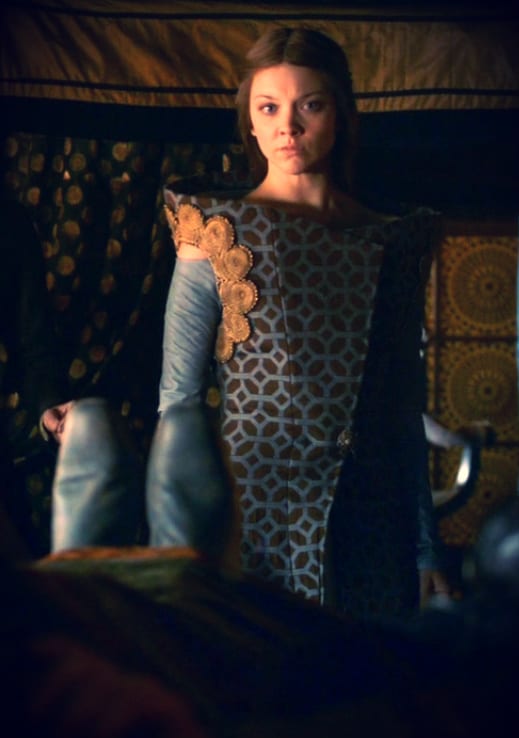
Let’s get the obvious out of the way first: this costume is ugly. It has no redeeming qualities. It isn’t fashion-forward in any sense. It isn’t interesting. It isn’t even well-made (note the seam where the pattern does not align: on the front of the damn garment!). I can’t even give credit where credit is due regarding the embroidery, which must have taken hours, because the embroidery is so ugly. This costume is also totally unlike anything else we’ve seen on screen before or since, though Cersei sports a similar neckline at times. But even calling it “similar” is a stretch.
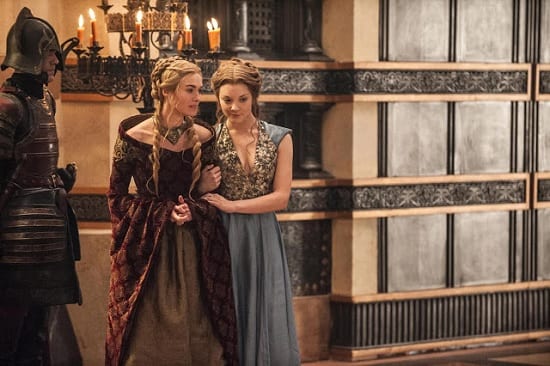
The colors on this dress aren’t even correct! The Tyrell colors are green and gold; the Baratheon’s are black and gold. This dress is blue and brown, with gold accents. Basically, someone over at Clapton & Co. had a kanipshin, and nobody seemed to think it proper to step the fuck up and stop this horror from making it to television.
With the sheer and objective ugliness of this costume in mind, let’s begin by breaking down its possible function within the GoTs universe.
Watsonian: the in-universe view and explanation of this god-awful pilates mat
At this time in the story, Marg is a fresh young queen, married to a man who has a tenuous claim on the Iron Throne. Husband Renly Baratheon has the biggest army in play at this point and, judging from his own attire, plenty of money to obtain appropriate clothing.
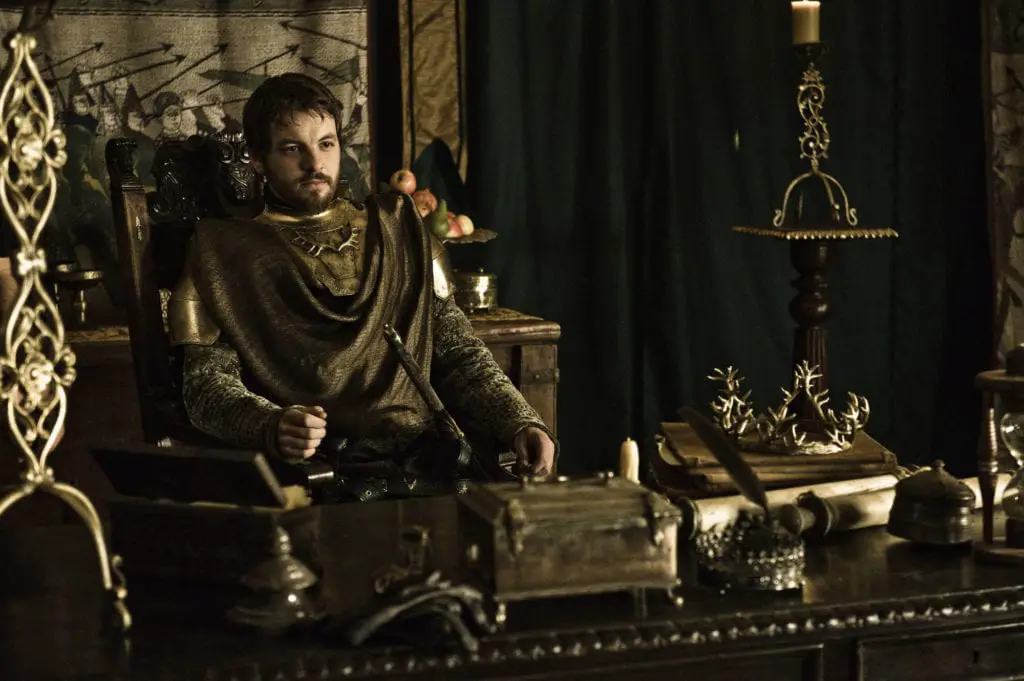
Marg, therefore, should benefit from her husband’s wealth. I mean, that’s literally the function of a feudal patriarchy when it comes to marriage—the combining of familial wealth and forces to create stronger alliances. A queen’s regalia should always match the level of her king’s, and vice versa. That is just the “reality”, for lack of a better term, of this fictional world.
And yet we are left with the grandma’s pillowcase dress. It literally has stitching like a quilt on the inside.
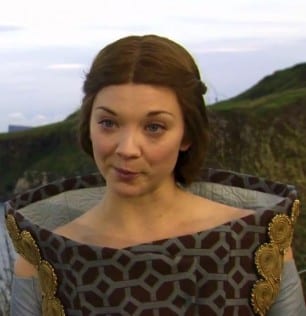
Following basic rules of the universe, the Watsonian logic doesn’t seem to be adding up here. The beauty and grace of this dress do not match the elegance of her husband’s clothing. Not to mention these two are supposedly royalty, so should be the epitome of class.
Let’s consider further the Watsonian issues here. First, who the hell made this dress within the GoTs universe? Obviously a real-life, modern person designs each costume, which we will discuss later. But the costumes must also make sense as garments that can be actually produced within the confines of the fictional universe. Considering we never see any other outfit remotely like this, it’s difficult to determine where Marg got this ruined bed sheet. This outfit looks out of place, like an abnormal design we would see at fashion week in New York.
While there are fashion trends in Westeros, there isn’t high fashion as we know it today. No one is picking bizarre pieces off the runways in Milan or opining over Vogue. There are no catwalks in the Reach, and there is no King’s Landing couture (though I wish there was!). Westeros is a world based on medieval human history, where men and women wore clothing to express their status in society. Clothing served a functional purpose and certainly did not step out of the norm to this extent. Indeed, multiple book characters directly address this problem. In A Feast for Crows, “Alayne Stone” carefully chooses an outfit fit for a bastard daughter as opposed to a trueborn because she is in disguise. Dress is also important to the station of the show characters—this is part of why the walk of shame was so difficult for show!Cersei, since she was literally stripped of her status. People in this universe are not pushing fashion boundaries, and there certainly are not fashion designers available to push those boundaries.
This puppy pad with arm holes would never have been created in this world. The seamstress responsible cannot exist; alternatively, she is the same time-traveling designer who visited the Riverlands in time to give Talisa a white medic’s smock.
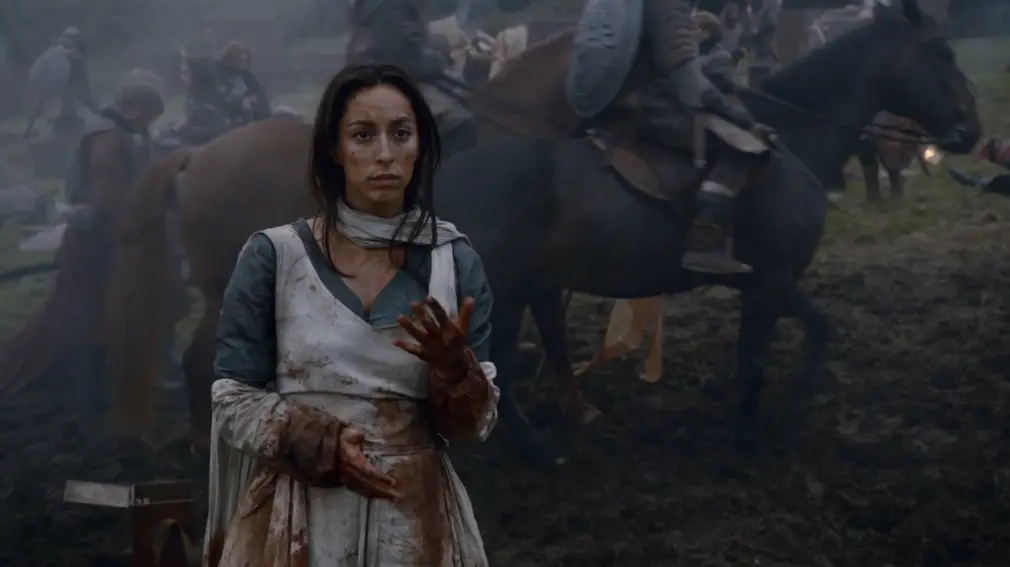
On top of there being the mystery of who designed the bedroll cone outfit, there’s another similar issue: where did they get the design? In modern life, fashion design can be a form of art (largely focused on high fashion and runway). Practicality of clothing gives way to intricacy and originality, allowing a designer to express themselves through the clothes. That kind of self-expression is very individualistic. It’s a form of art that focuses on the feelings of the designer, not the needs of the customer. Many outfits from fashion shows must be altered before they can be worn by regular people, as they are not designed for regular use.
In contrast, Westerosi fashion is not about the designer. It’s entirely about the person commissioning the clothes, and that person’s wealth, status, and family name. This makes sense, since a feudal society is dependent upon family fealty and large groups of people with varying degrees of power. The individual is not valued over the collective. As book!Arya tells us throughout her story: the lone wolf dies, but the pack survives.
The fact of the matter is, the clothing the characters wear is part of their characterization and the world-building of their society. A character’s appearance matters to themes and confidence in the world. Tyrion can’t walk around in jeans. Cersei can’t lounge in sweatpants and a t-shirt. Sansa can’t just show up in an outfit she picked out at Hot Topic and call it a day.
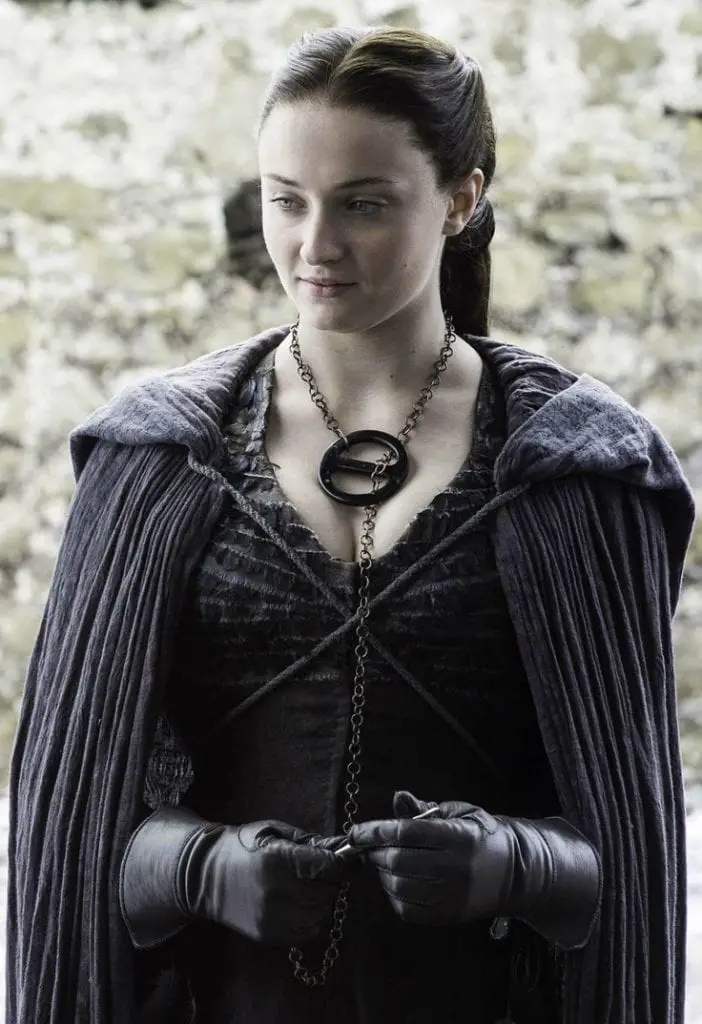
Seeing as the individual is not valued over the collective in this feudal society, it is impossible that a designer would create this cone dress for a young queen. Marg’s status in society dictates that she would have the most beautiful, elegant, detailed, chronologically appropriate gowns around. No Westerosi designer would dare to do otherwise.
The final piece of this puzzle comes down to Marg herself. If this designer did have this dumb idea, and the designer actually offered to make it for the queen, why would Marg pick it? Within the universe, we have no answer. Lucky for us our question is directly answered by Michelle Claption (“Clapton & Co.”), and brings us into the second part of our analysis.
Doylist: the real-life view and explanation of this god-awful pilates mat
“Margaery’s funnel dress was obviously an homage to the wonderful Alexander McQueen’s costume for Bjork. It just felt right that this young ambitious girl would be experimenting with shapes, honing her style skills which we now see her employing to great effect. It was a risk and divided the audience.” Michele Clapton, Vanity Fair
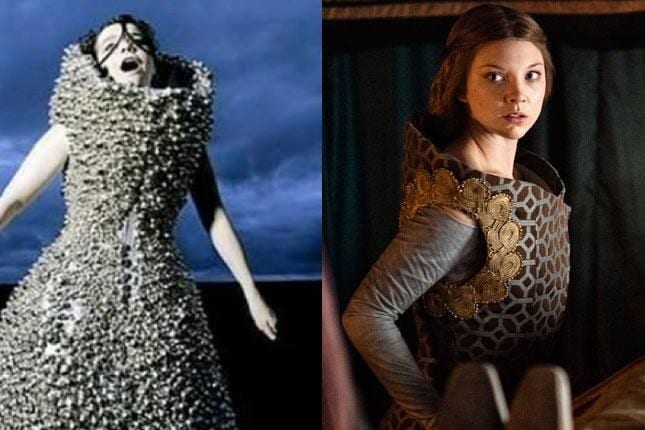
This is the explanation Michele Clapton herself provided when asked about the “funnel” dress from the seven hells. As we break down this quote, keep in mind that this comment came after the entire season aired, and after this costume received a substantial amount of negative feedback. A Doylist analysis demands we consider all the real-world factors going into design and statements about design, including the possibility of a tailored response (no pun intended) to criticism ex post facto.
Let’s look at this sentence-by-sentence. Clapton & Co. claim this dress was “an homage” to a Bjork costume. Okay. Let me be plain. It is inappropriate to reference a modern stage piece when designing a supposedly wearable dress for a queen in a medieval setting. Nothing about the original McQueen design fits into the needed time period: not the shape, not the colors, and not even the texture. There isn’t even a metaphorical, hipster-esque reference going on here. Bjork’s costume is shaped like a bell, made out of tiny bells. Last time I checked, the only bell in King’s Landing belonged to Unella.
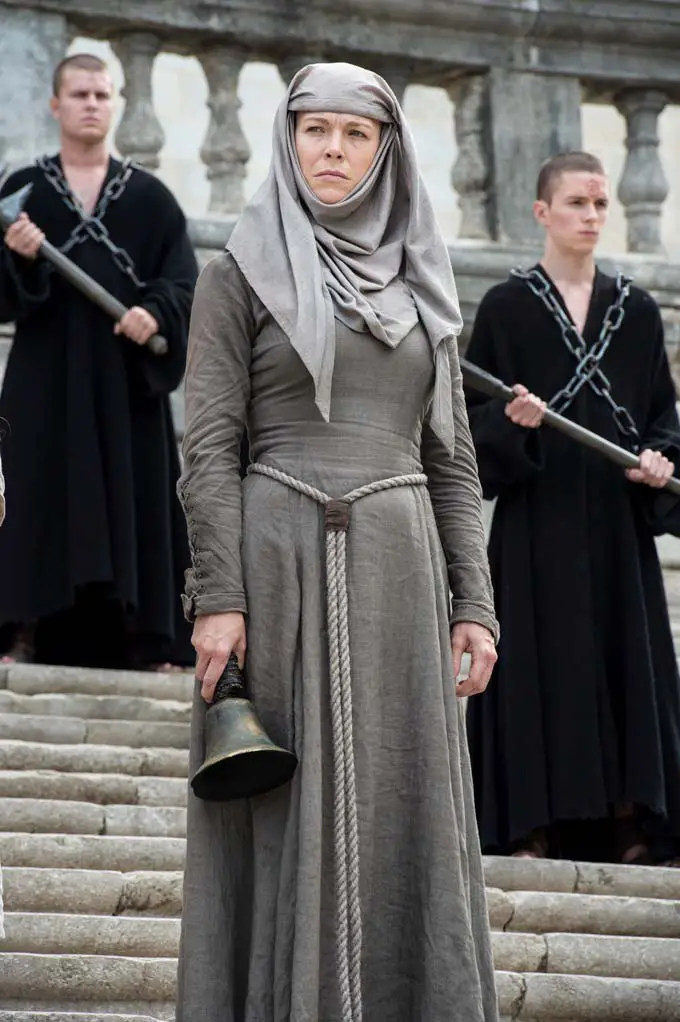
Like, dudes, I’m really reaching here. I want there to have been a reason. I want the Bjork thing to make sense. Because if it doesn’t make sense (and it doesn’t) then that I means I have to try and parse out the next few lines of this terrible explanation. Spoiler: it doesn’t get any better. Clapton & Co. goes on to answer our question from earlier. Why would Marg herself pick this bell-cone-funnel thing? As Clapton explains,
“It just felt right that this young ambitious girl would be experimenting with shapes…”
Pause. Does it? Does it feel right? Let’s understand this clearly. Clapton is saying that it’s right for a young queen, married to a man who tenuously has a claim to the throne (and certainly not the best claim), to experiment with “shapes”—in other words, with her wardrobe. This is an anachronistic understanding of medieval dress.
As discussed a bit above, medieval dress is different from fashion today. Not only is a medieval designer limited in their own self-expression, but the wearer of the garment is also limited. A person could only dress according to their station, and is expected to dress as well as their status permits. People certainly had their own opinions on clothing, and they could express themselves through their clothing to the extent of their station. However, conformity was often paramount, and teasing out agency relied on fully embracing their position in society.
We don’t even need to look to real medieval life to understand this! The books, which are surprisingly the source material for GoT, show repeatedly the importance of appearance and the implications of dress choice. And indeed, GoT itself understands this on many other occasions. The various wedding dresses that appear throughout the show are all ornate, one-of-a-kind pieces fit for that type of gathering. Highborn women wear certain styles, while lowborn servants or sex workers wear others. This fashion division existed in real life and in the novels. And it exists in GoT, which means Michele Clapton knows this is a constraint as she was the lead costume designer for five seasons.
Ultimately, it doesn’t make sense for Marg to “experiment” with her fashion choices. If anything, she should be solidifying her hold on the queenship by acting as a perfect queen, including dressing for the damn part. This is not the time to have a couture moment!
The next part of Clapton’s quote gives me further pause. She says Marg is, “…honing her style skills which we now see her employing to great effect.” Really? She employs the Bjork neckline to a great effect again? I guess I missed the Bjork influence on all those plunging v-neck flower dresses that follow the funnel.
If Marg did use the Bjork dress to hone her fashion skillz, all she must’ve learned was to never wear any shit like that again. We never see her in anything that pays any sort of homage to Bjork for the rest of the series, and thank the Seven that the yoga-mat “dress” dies a sudden and necessary death after season 2.
But there are still more questions here. If this was an experiment on Marg’s part, what stopped her? What made her go a full 180? The only explanation is that the experiment didn’t work—she never wears this style again and nobody else does. But how would Marg know the experiment didn’t work? I like to imagine Olenna pulled her aside and told her that if she wanted to bed a king she didn’t have to dress like a bed, but I’m probably just projecting.
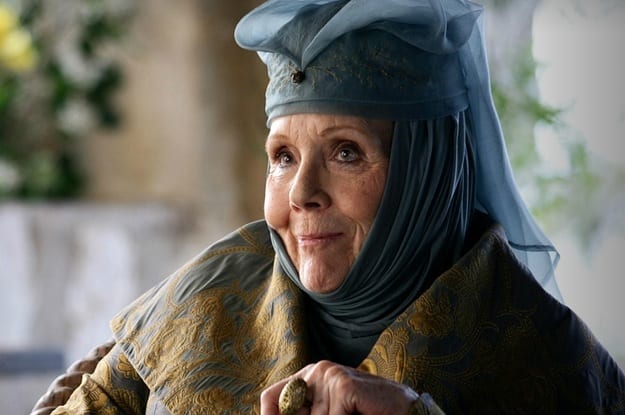
Herein lies the problem: if this was an experiment, how does the audience know? If it’s a failed experiment, who told us that? Clapton & Co. came up with a story about this dress, but the audience, the only people who would care about this story, was left completely out of the loop. None of the characters remark on her strange dress, and this chick has a whole conversation with Littlefinger. Littlefinger would be the perfect mouthpiece to express discomfort with an outfit.
(Just imagine his gravelly voice): “I’ve never seen gown like this before, my Lady.”
Marg: “It pleases me, and it pleases my king.”
Gravelly voice: “Yes, King Renly has always been pleased by…unique things.”
There’s a world of possible sick burns that could’ve come from that interaction, and we all know D&D are no strangers to including catty dialogue (even with men – see, e.g., Tyrion and Cersei). Instead, we are left with an ugly dress no one ever comments on. The audience can’t understand the experiment if everyone, including Marg, just plays it straight.
Seeing that all of the characters act like this dress is just fine, and since we are given no on-screen explanation of this fashion choice, it’s a little suspicious that Clapton excuses this design as an “experiment.” First, saying it was an experiment makes it look like Clapton intended this costume to be bizarre and anachronistic. Second, Clapton puts the agency of conducting this experiment on Marg, a fictional character who can’t argue back. Both of these things insulate Clapton & Co. from criticism for a bad design and a poor understanding of the setting. This is similar to when D&D claimed Cersei lied about her first born son with Robert in episode 1, season 1, which they had to say because they clearly forgot (or didn’t know about) the prophecy later on. Explanations given ex post facto should always garner strict scrutiny from the listener, since the criticized party has the opportunity to directly counter the criticism. Without more evidence that this design was intended as Marg’s experiment in fashion from its conception, I’m not inclined to believe it.
All in all, the cone dress of seven hells fails in all important ways. It’s ugly, it breaks in-verse rules, it has inappropriate real-life explanations, and its “story” is never expressed to the audience. Let’s be real – this costume was a mistake. Whatever the explanation, it was just poorly done.
In my opinion, the universe can only handle one Marg in a funnel dress at a time.

Repetitive Flower Dresses: Average Can Be Good!
Let’s face it: we’re not all high achievers. Sometimes shooting for average is enough, especially when you’re starting from the bottom. Clapton & Co. certainly started from the bottom going into season 3 when it came to Marg’s dresses, and they managed to pull it together, churning out a series of nearly identical costumes that I feel comfortable calling “fine”. The dresses all basically look like this:
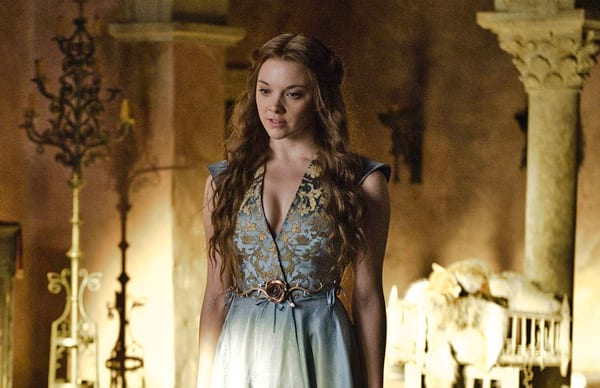
Same basic silhouette, same colors, and similar rose details. The costumes move nicely on screen, and they serve their basic functions. They’re medieval enough. Their construction is fine (it should be noted this is a difficult garment to construct). They’re pretty for their purpose. They function. They aren’t distractingly bad. I personally forgive a lot when there is beautiful fabric involved, and each dress has nice brocade on the bodice (it at least looks like brocade). Though I struggle with the weird cap sleeve thing happening on this iteration:
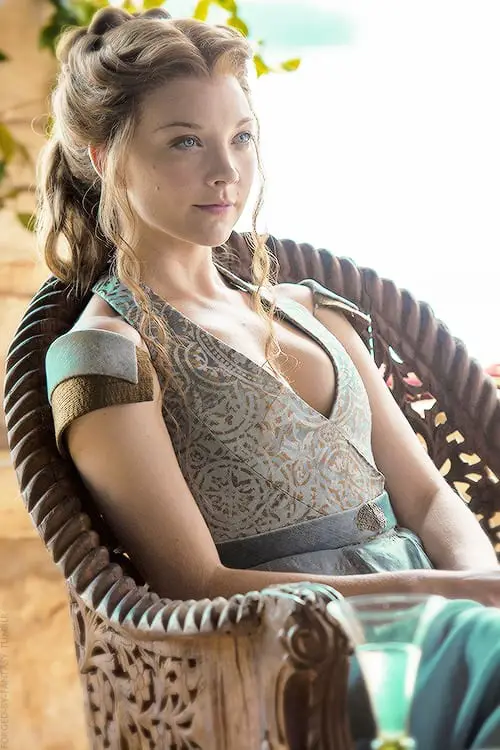
The only question I have regarding these dresses is about the weather in King’s Landing.
It gets sticky comparing one gown to another, since characters wear different styles based on region, family, wealth, and other factors. There are some interesting parallels I’ve noticed that pop up in weird instances that I still don’t understand, like Myranda borrowing Marg’s season 2 plunging neckline for a northern wedding.
Generally, I think it’s fair to compare dresses worn in the same geographical location by people of similar social rank. Logically, geography should dictate what type of clothing is worn, while status dictates the quality and use of the clothing. Khaleesi Daenerys, for instance, wears sleeveless riding gear with the Dothraki, while Queen Daenerys in Meereen still wears sleeveless outfits, but instead as royal garments.
That brings us to King’s Landing, season 3 (and some of season 4). We get Marg in her series of average copy/paste dresses, literally standing next to women in long-sleeved, full-length gowns.
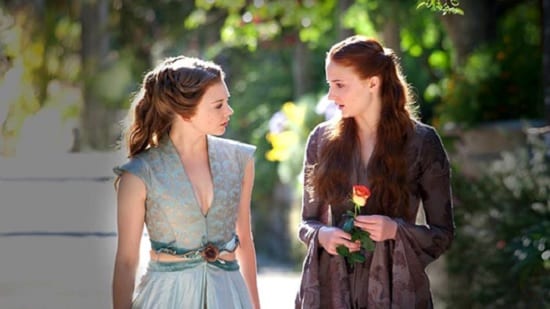
Marg appears in multiple scenes with Sansa, where the latter is wearing a full gown. Sansa’s dresses must have underskirts and other shananigans beneath them—so she’s in long-sleeved layers. Meanwhile Marg is chillin (perhaps literally) in her light-weight outfits.
Marg similarly appears alongside Cersei, but this phenomenon isn’t limited to highborn ladies. Every other main character Margaery stands with is wearing long sleeves. King Joffery, Brienne of Tarth, And even Margaery’s brother, when shown in King’s Landing but out of his armor, wears long-sleeves.
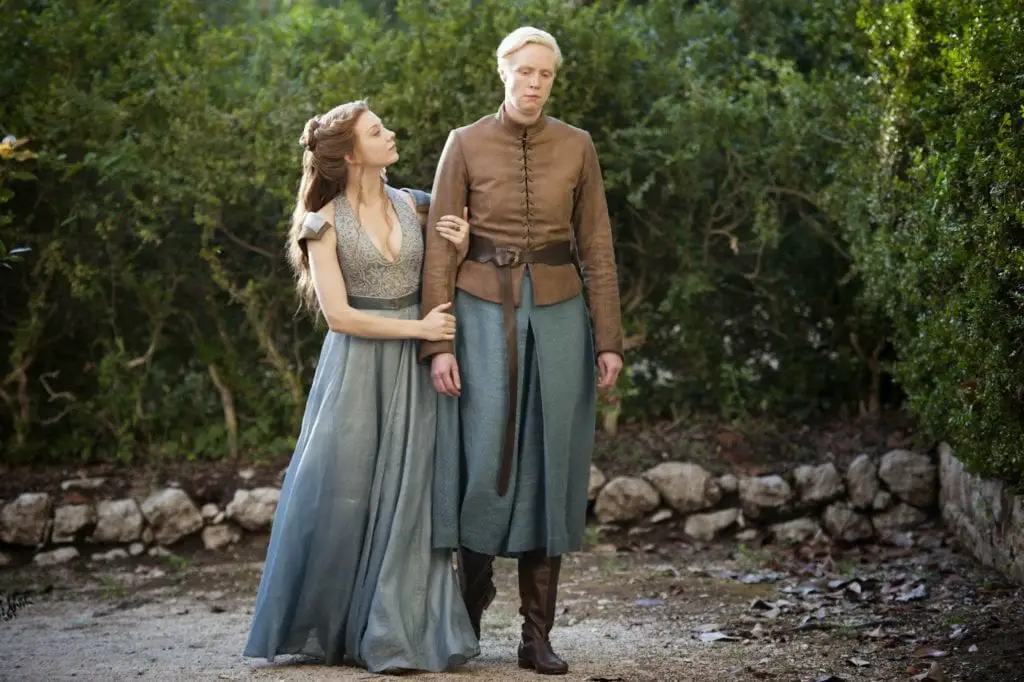
No one else in King’s Landing dresses as light as Marg. And this is a real concern, as we often hear: winter is coming! Clothing must conform to the geographical temperature or you will actually die.
Luckily, this is one costume design the script is moderately aware of. In episode 1, season 3, both Joffrey and Cersei comment on Marg’s different gown – specifically, the dress with the cut-outs at the waste. You can watch the scene here. It opens with Joffrey:
Joffrey: “That’s a lovely gown, my lady.”
Actor Jack Gleeson, who embodied Joffrey throughout his time on GoTs, delivers this line with a hint of flirtation. That’s the first indication the audience gets that the gown is supposed to be sexually attractive. Cersei notices too, and jumps in before Marg can answer:
Cersei: “Yes, it suits you perfectly. Though I imagine you might be rather cold.”
This is one of the few moments where show!Cersei and I had the exact same thought. Everyone else in the room is wearing long-sleeves, including Loras Tyrell. Marg’s explanation to the queen is:
Marg: “The climate is a bit more forgiving back in Highgarden, your grace.”
Okay. So? Is she in Highgarden right now? Did neither she nor any of her servants consider that she might need warmer clothing for King’s Landing? Also, Marg hasn’t been in Highgarden for some time – she was busy wearing a funnel with Renly somewhere near Storm’s End. This isn’t an acceptable explanation, but none of the characters care as Joffrey asks:
Joff: “Shall I have them bring you a shawl, my lady?”
Marg: “I am touched by your concern, your grace. Luckily for us Tyrells our blood runs quite warm, doesn’t it Loras?”
Loras: [looking at the queen] “Yes.”
Natalie Dormer, Marg’s actress, does a great job delivering her line with a bit of flirtation as well. This scene solidifies this dress as sexy, to the point that even the script noticed. It does nothing to give an adequate Watsonian explanation, though. Loras may claim to be hot-blooded, but he’s still standing there in long-sleeves and long pants.
There are some issues here with the Watsonian, in-verse explanation of these dresses. They’re obviously too cold for the climate, based on what we see and what we are told by Cersei. The explanation is that Marg is trying to be sexy for Joffrey, which feeds into D&D’s unfortunate understanding of Marg as the sexual manipulator. But even so, you can be sexy without being as naked as possible. Given the constraint of temperature, I find it hard to believe that Marg would run around King’s Landing freezing her ass off because she wants to seduce a man she’s already legally betrothed to. Like, what is she gaining from this? She is already set to be queen because the Tyrells saved the day at Blackwater bay! This just isn’t necessary.
In some instances, looking at the book description can shed light on what happened in the “adaptation” on screen. Here, there is no parallel dress in the text that is like these light flower dresses Marg wears. Mostly the text describes Margaery’s hair and eyes, her demeanor and movement, and the colors that she wears (her wedding dress is an exception). Considering that Margaery is not a scheming sexual manipulator in the text, along with the lack of description of any gown like what appears on screen, it seems the “source material” did little to inform Clapton & Co.’s design decisions.
In order to find another similar gown, the audience must look outside of King’s Landing. The only other dress with a similar cut and style on a man character, particularly with the waste cut-outs, appears on Daenerys in season 4.
Of course, the problem with these two costumes having similar styles is that they are from extremely different places. One is on a woman raised in southern Westeros who moves to the capitol city to be in the King’s court; the other is on a woman who has grown up almost entirely in Essos forming her own Queen’s court in one of the oldest cities on the planet. The similarity is not good from a world-building perspective. Any cursory glance at the Planetos map shows how unlikely it is that fashion trends would be remotely similar in the two places.
Overall, the in-verse explanations don’t stand muster. The climate in King’s Landing is likely too cold for these outfits. Marg’s motive to keep on keepin’ on and suffer through the unpleasant cold is thin: she’s seducing a king to whom she is already betrothed. Additionally, that seduction can happen without baring it all. Book!Joffrey is quite taken with Margaery based on her beauty and grace, not any overt sexual manipulation. Since just not wearing an out-of-place dress is a perfectly viable option, there isn’t much honeypotting that can excuse the Watsonian problems of this design.
With a fragile Watsonian explanation, we need to look to the Doylist purpose. I think this is pretty easy to figure out, especially if you take a moment to consider the difference between Margaery Tyrell of the books and Marg Bolelyn of the show. The script treats Marg as a straight-up sexual manipulator, using her sexuality to seduce first Joffrey and later Tommen. This idea must have been communicated to the costume department (at least the writers told Clapton & Co. something!), and the designers subsequently created risqué semi-medieval dresses for Marg. The costumes at least fulfill their purpose…to solidify Marg as the sexy young queen and highlight her sexual manipulation of various kings.
I don’t fault the costumes for this problematic view of Marg. Clapton & Co. did what they were told by the scripting, albeit without the consideration of climate or how ridiculous Marg would look next to other fully dressed ladies of the court. This is a case of the Doylist reason for the design reflecting the inept writing. Unfortunately, the showrunners are responsible for the tone of the entire project, and they set the Marg-is-oh-so-sexy vibe from the very top. Like we saw with Dany, D&D’s confused storytelling permeates the costume design for Marg. Starting from an inaccurate point, there are only so many directions a costume designer can go.
It appears that even costumes that seem simple weaken under scrutiny. I know there are outfits on this show designed by Clapton & Co. that are glorious, perfect examples of costuming. But for now we are stuck talking about Marg—and what does Michele Clapton say about creating excellent designs for Marg Tyrell?

Look for further analysis of Marg in the next installment of A Song of Pins and Needles.

